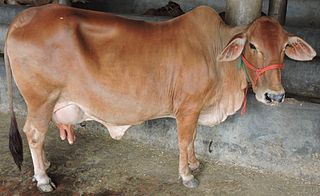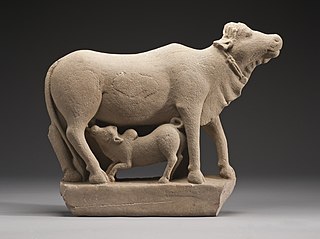
The water buffalo, also called the domestic water buffalo or Asian water buffalo, is a large bovid originating in the Indian subcontinent and Southeast Asia. Today, it is also found in Europe, Australia, North America, South America and some African countries. Two extant types of water buffalo are recognized, based on morphological and behavioural criteria: the river buffalo of the Indian subcontinent and further west to the Balkans, Egypt and Italy and the swamp buffalo, found from Assam in the west through Southeast Asia to the Yangtze valley of China in the east.

Dairy cattle are cattle bred for the ability to produce large quantities of milk, from which dairy products are made. Dairy cattle generally are of the species Bos taurus.
The BAIF Development Research Foundation is a NGO based in Urali Kanchan near Pune in Maharashtra, India, that pioneers agricultural development. It was founded in 1967 by Manibhai Desai as the Bharatiya Agro Industries Foundation. Under Manibhai, BAIF pioneered cross breeding of high yielding European cattle such as Holstein Freisian and Jersey with the sturdy Indian breeds such as Gir from Gujarat. Later BAIF expanded the scope of activities to include animal health, nutrition, afforestation wasteland development, and tribal development.

Sahiwal cattle is a breed of zebu cow, named after an area in the Punjab, Pakistan. The cattle is mainly found in Punjab province of Pakistan, and Indian states of Punjab, Haryana, & Rajasthan.

The Philippine Carabao Center an attached agency of the Department of Agriculture, was established at Science City of Muñoz in Nueva Ecija province in 1992 to breed and cross carabao based on high-yield Murrah buffalo in the Philippines as a multi-purpose animal that can be raised for milk, meat, hide, and draft.

GSDP of Haryana state was US$85 billion in 2016–17 which had grown at 12.96% CAGR between 2012–17, boosted by the fact that this state on DMIC in NCR contributes 7% of India's agricultural exports and 60% of India's Basmati rice export, with 7 operational SEZs and additional 23 formally approved SEZs also produces India's 67% of passenger cars, 60% of motorcycles, 50% of tractors and 50% of the refrigerators, which places Haryana on 14th place on the list of Indian states and union territories by GDP behind only much bigger states that are significantly larger in both area and population. As per Nov 2016 data, Gurugram ranks number 1 in India in IT growth rate and existing technology infrastructure, and number 2 in startup ecosystem, innovation and livability.
In Sri Lanka many farmers depend on animal husbandry for their livelihood, but not a large proportion. Therefore, many livestock products have to be imported. The main livestock products in Sri Lanka are milk, meat and eggs. Hides, wools and other products are still not produced within the country. Animal power formerly used in the cultivation of rice and vegetables have been replaced by modern technology to farmlands. However animal husbandry plays an important role in the rural economy for improving the living conditions of farmers in the country.

Bhadwari is an improved water buffalo breed from Uttar Pradesh, India, that is kept for milk production mainly in the Agra and Etawah districts, and in the Bhind and Morena districts of Madhya Pradesh. Cows usually lactate during 272 days with an average milk yield of 752–810 kg (1,658–1,786 lb) in this period.
Datta is a village located in Hisar district in Haryana, India. Datta is a village in Hansi Tehsil of Hisar district in Haryana State of India. It is situated 36 km from Hisar city and 20 km from Hansi city on the road to Datta which also leads to Barwala. At Datta there is another road that leads to Narnaund. It is 15 km from Narnaund Tehsil and only 16 km from Barwala town. Datta comes under Roghi Khap Panchayat. There is an oil depot of HPCL situated on bianakhera road.
Madha is a village of Jats located in Hissar district in Haryana, India.

Being a country that has a largely rural and agriculture-based industry, animal husbandry plays an important role in the economy of Pakistan and is a major source of livelihood for many farmers. It is estimated that there are between 30 and 35 million people in Pakistan's current labour force who are engaged in livestocks. While the agricultural practice is prevalent throughout the entire country, it is more common in the fertile provinces of Punjab and Sindh, which are traditionally the main areas of agriculture and farming activity. In 2020, the livestock industry was contributing 60.6 % to overall agriculture and 11.7 % to the GDP.

The following outline is provided as an overview of and topical guide to Haryana.

Hariana or haryanvi is an Indian breed of cow native to North India, specially in the state of Haryana. They produce about 10 to 15 litres of milk a day, compared to 8.9 litres when cross-bred with Holstein Friesian cattle (HS), whereas pure HS can produce 50 litres a day, but it is not as disease-resistant in the conditions of North India.
Central Institute for Research on Buffaloes, Hisar, a publicly funded, institute for water buffalo research. It is located 170 kilometres (110 mi) from Delhi, at Hisar in the north Indian state of Haryana. It has a sub-campus, Bir Dosanjh, at Nabha. CIRB operates a nationwide network of 10 research centres working on breed improvement of the 7 main native breeds. CIRB, with over 20 laboratories for buffalo research, is the world's largest buffalo research institute with the widest range of breeds under study. With the aim of improving breeds and dissemination of information, CIRB has sold over 1,000 bulls, conducted ~200,000 artificial insemination in the field for the farmers' buffaloes with a 41% conception rate, distributed ~520,000 progeny tested frozen semen kits to 45,000 farmers and over 250 institutes, imparted training to several thousand farmers on advanced buffalo husbandry, and created the world's first online Buffalopedia in several languages. It has a large research partner network across India and the globe. It is the second institute to successfully clone a buffalo in 2016, after the first successful cloning was achieved by the National Dairy Research Institute, Karnal in 2010. In July 2017, the Indian Council of Agricultural Research ranked CIRB Hisar as India's number one Buffalo research institute for the year 2016–17.
Government Livestock Farm, Hisar, Asia's largest livestock breeding, research and training institute, is a public funded institute located at Hisar of Haryana state in India.
Indo-Israeli Centre of Excellence for Animal Husbandary & Dairying, Hisar, will be built by Haryana State in collaboration with MASHAV. The centre will operate in the field of research and training for cost-effective and innovative localised animal husbandry in India and dairy technologies for the intensive dairy production system of global standards to enhance per capita availability of milk. It is located within the Government Livestock Farm at Hisar in Haryana state of India.
Animal husbandry in Azerbaijan is concerned with animals that are raised for meat, milk, eggs, leather, wool, fur and fibre production for people’s consumption in Azerbaijan.

Dairy plays a significant part in numerous aspects of Indian society, including cuisine, religion, culture, and the economy.











